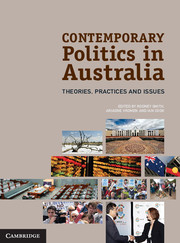Book contents
- Frontmatter
- Contents
- Tables and figures
- Contributors
- Acknowledgements
- Introduction
- I Contemporary Theories of Australian Politics
- Part II Politics in Everyday Australian Life
- Part III Elections
- Part IV Participation and Representation
- Part V Inside the Australian State
- Introduction to Part V
- 19 Parliament
- 20 Prime ministerial government in Australia
- 21 Politicisation and the executive
- 22 Delivering public policy
- 23 The courts
- 24 Federalism
- Part VI Contemporary Public Controversies
- Glossary
- References
- Index
Introduction to Part V
from Part V - Inside the Australian State
Published online by Cambridge University Press: 05 June 2012
- Frontmatter
- Contents
- Tables and figures
- Contributors
- Acknowledgements
- Introduction
- I Contemporary Theories of Australian Politics
- Part II Politics in Everyday Australian Life
- Part III Elections
- Part IV Participation and Representation
- Part V Inside the Australian State
- Introduction to Part V
- 19 Parliament
- 20 Prime ministerial government in Australia
- 21 Politicisation and the executive
- 22 Delivering public policy
- 23 The courts
- 24 Federalism
- Part VI Contemporary Public Controversies
- Glossary
- References
- Index
Summary
The events following the 2010 federal election threw many of the issues raised in this chapter into stark relief. A hung parliament – which meant that a group of Independents became crucial to a formation of a government (or political executive) – made it clear that members of the lower house of parliament select or elect the executive. This has been obscured by strict party discipline, which – as Norman Abjorensen and John Uhr discuss in Chapter 19 – has meant the federal parliament has had limited independence, especially from the political executive. Among the demands presented to the rivals for government by the three Independents were some that were directed towards increasing parliament’s capacity to scrutinise the actions of members of the political executive, and hold them accountable.
The fact that parliamentary leaders have become the focal points of campaigning and party control has shifted power even further. Once the control that the party exerted over parliament was concentrated in the hands of the party leader, the control of parliament – and the executive itself – moved further towards the prime minister. As Paul Strangio suggests in Chapter 20, this has led to the emergence of prime ministerial governance. The reversal of this process after the 2010 election allowed Independents to force a caretaker prime minister and her ministers, an opposition leader and his shadow ministers, and senior public servants to explain and justify the policies and budget that would be introduced by a Labor or Liberal–National Coalition government.
- Type
- Chapter
- Information
- Contemporary Politics in AustraliaTheories, Practices and Issues, pp. 212 - 213Publisher: Cambridge University PressPrint publication year: 2012



